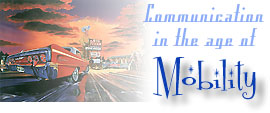
Office: HGH 210; phone: (408) 924-5378
Email: wooda@email.sjsu.edu
Web: http://www.sjsu.edu/faculty/wooda
 |
Dr. Andrew Wood Office: HGH 210; phone: (408) 924-5378 Email: wooda@email.sjsu.edu Web: http://www.sjsu.edu/faculty/wooda |
Introduction
: Course Calendar : Policies
: Readings
Assignments : Check Your Grades : Return
to Frontpage
This summary is authored by Jonathan Bunting.
Reading: Wood, A. (2003). A rhetoric of ubiquity: Terminal space as omnitopia. Communication Theory, 13:3, pp. 324-344.
Study Guide:
Focus on the following components when planning for the quiz: (1) two languages that provide the origin for 'omnitopia,' (2) research method used for this analysis, (3) name of the bar located in some airports, (4) slogan for InMotion DVD service, and (5) name of website related to sleeping in airports
Have you ever noticed
that fast food restaurants all look alike, how shopping malls usually have similar
architecture, or how we generally avoid making true connections with others
when in an airport? Fast food restaurants encourage us to order quickly with
convenient Value Meal options. Malls are built allow us to compare prices and
make purchases smoothly. In airports we jet -- pun intended -- around slower
individuals through the terminal to our gate, often ignoring even those who
speak to us.
Why is this so?
In his article "A rhetoric of ubiquity: terminal space as omnitopia,"
Wood illustrates the growing phenomena of homogenous world -- a world where
corporate America has seamlessly made places of commerce and travel have a look
and feel that is identical to each other yet so different from home that we
alter our behavior without question. Using the airport's terminal space as an
example, Wood analyzes how public areas are increasing in similarity no matter
where you are in the world. Further, this monotone sameness of modern life is
effectively blurring public and private life. In essence, when we are home we
are still actually connected to the world around us via communication technologies.
The homogenous public space like an airport terminal is dubbed omnitopia.
The article denotes that for public space to have the qualities of omnitopia
it must meet three criteria:
1) the individual places, whether they be in Paris or Jakarta, must look similar
to each other (generic environments), 2) people do not stay
in the same place for prolonged periods (continual movement),
and 3) interchange between individuals moving through an omnitopia is fragmented
(atomized interactions).
Wood's choice of the airport terminal as an example shows the reader all three
criteria. Most airports look alike. You continually move within the airport
be in from security, to bag check, to the airport Starbucks, to the boarding
gate. Finally, we view others as simple obstacles to our goal (board the plane!),
rarely considering that they, too, are fellow members of the human race who
probably have the exact same goal we do.
Wood argues that unless we recognize this increasing trend in omnitopia, places
all over the world will lose their flavor and eventually even entertainment
and private lives will be invaded with an inescapable banality, and that true
communities will become increasingly difficult to find.
Activity
Select a brief scene from a film that depicts an airport or airplane. For your
Show and Tell activity, provide three specific
aspects of this scene to illustrate one or more concepts explored in the Wood
piece.